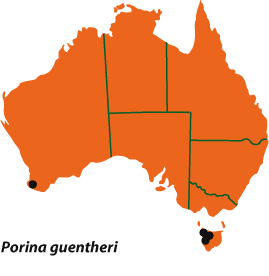



Australian Biological Resources Study
| Checklist of the Lichens of Australia and its Island Territories | ||
| Introduction | A–D | E–O | P–R | S–Z | Oceanic Islands | References | ||
| Porina guentheri (Flotow) Zahlbr. | ||
| Cat. Lich. Univ. 1: 384 (1922); Verrucaria guentheri Flotow, Bot. Zeitung (Berlin) 8: 575 (1850). T: Riesengebirge, [Czech Republic], 4 Sept. 1846, coll. unknown; syn: UPS. | ||
| Thallus epilithic, continuous to areolate, pale to medium grey-brown or dark olive-green, matt, smooth to minutely rugulose, 30–100 µm thick, ecorticate; prothallus not apparent. Algae Trentepohlia; cells 7–18 × 7–14 µm. Perithecia almost superficial, hemispherical to subglobose, 0.23–0.48 mm diam., black; apex rounded; ostiole inconspicuous or in a 40–50 µm wide papilla. Involucrellum greenish black or purple-black in thin section, contiguous with the exciple, sometimes incurved beneath, 40–110 µm thick, not containing algae, K+ reddish brown. Exciple 15–25 µm thick, hyaline to purple-black. Centrum 0.18–0.31 mm wide. Asci elongate-cylindrical to narrowly obclavate, 80–130 × 10–14 µm. Ascospores fusiform to elongate-fusiform, (3–) 5–7 (–9)-septate, 22–49 × 3.5–6.5 µm, without a distinct perispore. Pycnidia semi-immersed to superficial, 60–150 µm diam., black. Conidia fusiform to bacilliform, 2–4 × 0.5–1.2 µm. |  |
|
| Occurs in south-western W.A. and Tas.; grows on moderately to deeply shaded siliceous rocks. A ±cosmopolitan species, especially common in temperate regions (including southern South Africa and New Zealand); occasional in the eastern Palaeotropics. | ||
| McCarthy (2001b) | ||
| Checklist Index |
| Introduction | A–D | E–O | P–R | S–Z | Oceanic Islands | References |
This work is copyright. Apart from any use as permitted under the Copyright Act 1968, no part may be reproduced by any process without prior written permission from Australian Biological Resources Study. Requests and inquiries concerning reproduction and rights should be addressed in the first instance to Dr P. McCarthy. These pages may not be displayed on, or downloaded to, any other server without the express permission of ABRS.